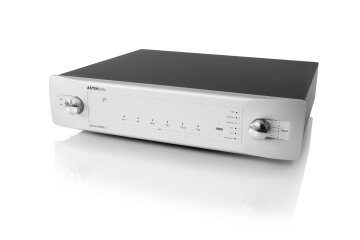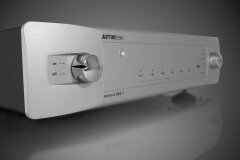Astin Trew Concord DAC 1
Offers Asynchronous USB or FireWire modules in 24bit/192kHz and comprehensive inputs/outputs including hybrid RCA output.
Price: £3780.00
The Concord DAC 1 offers a world class audio design with a modular upgradable construction to accommodate future hardware and software upgrades, ensuring the DAC 1 will never become a redundant investment.
It has been designed to offer you the very best musical presentation from your digital music library, up to 24bit / 192kHz data via either asynchronous USB or FireWire options, and both S/PDIF (4 options) and I2S data inputs.
The Concord CDT 1 (CD transport in the Concord range) outputs I2S data, ensuring the highest quality sound from your CD collection through the DAC 1 I2S input. Audio signal outputs to a pre-amplifier or integrated amplifier are through either a single ended (RCA) tube (valve) buffered circuit or fully balanced (XLR) connectors using solid state circuitry.
The Concord DAC 1 has many technical and design features that ensure you are listening to a most faithful and musical reproduction of your digital music data. Astin Trew have a distinct philosophy regarding music reproduction – put simply, it has to sound like real music in a hugely entertaining and faithful way. The Concord DAC1 offers this in spades!
MD Michael Osborn at Astin Trew says:
'It is relatively easy to design a DAC with very impressive specifications, but our extensive listening tests show us that, particularly with USB and FireWire data inputs, a lot of DACs do not sound ‘right’, often sounding too mechanical or too aggressive or even sometimes too ‘laid back’, and lacking coherence across the frequencies and credible three-dimensional imaging - or combinations of these shortcomings. We have sought to offer all the detail that is now available from large digital music files in a way that sounds musical, engaging and real. A DAC that can present music enjoyably for hours on end. Here are some of the ways we have achieved this:
Power supplies are one of the most critical areas of any quality audio equipment. DAC1 has 6 separate supplies, using very low noise low impedance circuits. The digital and analogue boards also have additional regulators supplying the individual stages to ensure a clean supply, lowest noise and isolation between circuits.
The mains power input goes through a high quality very low impedance input filter to isolate the DAC circuitry from incoming mains ‘noise’, particularly in the very high frequency ranges. Digital input signals are galvanically isolated to remove earth or ground-line ‘noise’ from incoming signals.
Digital-to-analogue processing is provided through two Burr Brown (T.I.) PCM1794 D/A converters running in dual mono configuration, offering 132dB dynamic range, a THD+N of 0.0004% and true dual mono from the processor onward, eliminating left/right channel crosstalk. We have found that these D/A converters simply offer the ‘best sound’ when used in dual mono mode and implemented correctly, together with our analogue circuitry. No fancy digital filters are used to ‘improve’ the incoming data streams as we do not find them necessary to achieve excellent sound quality, quite the reverse in fact.
The first amplification stages run in ‘class A’, offering a substantial sound quality improvement – a hybrid tube (valve) amplifier design is used at the single ended output, offering the audible benefits of both tube amplification and transistor based designs. The balanced outputs use solid state circuitry. The tubes in the buffer amp are under-run and should last for years, even if you leave the DAC on for extended periods.
The ‘black art’ of component selection to achieve the very best sound qualities cannot be underestimated. Many months of evaluation and selection of high quality components has been undertaken, including internal cable selection, resistors, capacitors, I.C.’s etc. The final component specification offers a balance of great transparency, dynamics, speed and sound-staging; combined with a ‘musicality’ that offers stress-free listening over extended periods.
Regarding the visual design, much of the casework and the substantial fascia are made from aluminium, with internal bracing and damping materials. The supporting feet are made from self-damping composite materials to our design. Even the case cover coating has anti-resonance properties. The analogue circuit board is ‘floating’ on silicon isolation supports to further reduce micro-vibrations that affect sound quality at this critical stage. The subtle fascia sculpting and clean design of the fascia, alongside casework with no visible fixings complete the package.'


